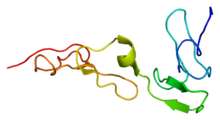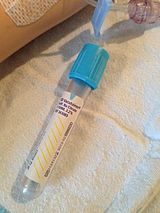Protein S deficiency
| Protein S deficiency | |
|---|---|
 | |
| Protein S structure | |
| Specialty | Hematology |
| Symptoms | Purpura fulminans[1] |
| Causes | Vitamin K deficiency[1] |
| Diagnostic method | Coagulation test[1] |
| Treatment | Heparin, Warfarin[2] |
Protein S deficiency is a disorder associated with increased risk of venous thrombosis.[1] Protein S, a vitamin K-dependent physiological anticoagulant, acts as a nonenzymatic cofactor to activate protein C in the degradation of factor Va and factor VIIIa.[3]
Decreased (antigen) levels or impaired function of protein S leads to decreased degradation of factor Va and factor VIIIa and an increased propensity to venous thrombosis. Some risk factors for deep vein thrombosis or pulmonary embolism in patients with protein S deficiency include pregnancy, older age, hormonal therapy, consumption of birth control pills, recent surgery, trauma, and physical inactivity.[4] Protein S circulates in human plasma in two forms: approximately 60 percent is bound to complement component C4b β-chain while the remaining 40 percent is free, only free protein S has activated protein C cofactor activity[medical citation needed]
Signs and symptoms
[edit]Among the possible presentation of protein S deficiency are:[1][2][5][4]
- Thrombosis of lower extremities
- Superficial thrombophlebitis
- Redness in affected area
- Purpura fulminans
- Pulmonary embolism
- Stroke (in children)
Cause
[edit]
In terms of the cause of protein S deficiency it can be in inherited via autosomal dominance. A mutation in the PROS1 gene triggers the condition. The cytogenetic location of the gene in question is chromosome 3, specifically 3q11.1[6][7] Protein S deficiency can also be acquired due to vitamin K deficiency, treatment with warfarin, liver disease, kidney disease, chemotherapy, infection, surgery, birth control pills, pregnancy,[4] and acute thrombosis (antiphospholipid antibodies may also be a cause as well)[1]
Pathophysiology
[edit]In regards to the mechanism of protein S deficiency, Protein S is made in liver cells and the Endothelium.[8][9] Protein S is a cofactor of APC both work to degrade factor V and factor VIII. It has been suggested that Zn2+ might be necessary for Protein S binding to factor Xa.[2][10]
Mutations in this condition change amino acids, which in turn disrupts blood clotting. Functional protein S is lacking, which normally turns off clotting proteins, this increases risk of blood clots.[6]
Diagnosis
[edit]
The diagnosis for deficiency of protein S can be done as part of a thrombophilia investigation, along with reviewing family history of thrombotic disease.[1][11][12] Testing for protein S deficiency should be delayed if there are causes for acquired deficiency or interfering factors.[13]
The initial assay for congenital protein S deficiency should be the free protein S antigen assay. If the level is low, total protein S antigen assay can be performed to differentiate between type I and type III deficiency. Protein S activity assays may be useful in patients with a normal free protein S antigen in occasional situations: 1) if no abnormality is identified during a thrombophilia workup, but clinical suspicion persists; or 2) in specific populations in which type II deficiencies are more common.[13]
Screening with a free protein S antigen assay is preferred because there are fewer interferences compared to assays for protein S activity, as well as better assay performance characteristics.[13]
Differential diagnosis
[edit]Other causes for thrombophilia are- Antiphospholipid syndrome, Factor V Leiden and Prothrombin G20210A mutations, protein C deficiency and antithrombin deficiency (though this list is not exhaustive)[2]
Types
[edit]There are three types of hereditary protein S deficiency:[2][6]
- Type I – decreased protein S activity: decreased total protein S levels, as well as decreased free protein S levels
- Type II – decreased in regards to the cofactor activity of the protein
- Type III – decreased protein S activity: decreased free protein S levels (normal total protein S levels)
Treatment
[edit]
In terms of treatment for protein S deficiency the following are consistent with the management (and administration of) individuals with this condition (the prognosis for inherited homozygotes is usually in line with a higher incidence of thrombosis for the affected individual[1]):[2][10]
- Unfractionated heparin (w/ warfarin)
- LMWH/Low molecular weight heparin
- Dabigatran
- Direct Factor Xa Inhibitors
- Graduated compressed stocking
- High degree of prophylaxis
References
[edit]- ^ a b c d e f g h "Protein S Deficiency. Learn about Protein S Deficiency | Patient". Patient. Retrieved 2016-10-16.
- ^ a b c d e f "Protein S Deficiency: Background, Pathophysiology, Epidemiology". 2016-05-02.
{{cite journal}}: Cite journal requires|journal=(help) - ^ "Protein S: Reference Range, Collection and Panels, Interpretation". 2016-06-01.
{{cite journal}}: Cite journal requires|journal=(help) - ^ a b c "Protein S Deficiency". Cleveland Clinic. Retrieved 7 February 2023.
- ^ "Congenital protein C or S deficiency: MedlinePlus Medical Encyclopedia". medlineplus.gov. Retrieved 16 October 2016.
- ^ a b c Reference, Genetics Home. "PROS1 gene". Genetics Home Reference. Retrieved 16 October 2016.
- ^ Reference, Genetics Home. "protein S deficiency". Genetics Home Reference. Retrieved 16 October 2016.
- ^ "Endothelial Cells, Volume 1, 1988, p158, By Una S." Retrieved 24 January 2019.
- ^ Burstyn-Cohen, T.; Heeb, M. J.; Lemke, G. (2009). "J Clin Invest. 2009 Oct, 119(10):2942-53, Burstyn-Cohen T1, Heeb MJ, Lemke G: Lack of protein S in mice causes embryonic lethal coagulopathy and vascular dysgenesis". The Journal of Clinical Investigation. 119 (10): 2942–53. doi:10.1172/JCI39325. PMC 2752078. PMID 19729839.
- ^ a b Ten Kate, M. K.; Van Der Meer, J. (1 November 2008). "Protein S deficiency: a clinical perspective". Haemophilia. 14 (6): 1222–1228. doi:10.1111/j.1365-2516.2008.01775.x. ISSN 1365-2516. PMID 18479427. S2CID 26719614.
- ^ "Protein S blood test: MedlinePlus Medical Encyclopedia". medlineplus.gov. Retrieved 16 October 2016.
- ^ "Protein S deficiency - Conditions - GTR - NCBI". www.ncbi.nlm.nih.gov. Retrieved 16 October 2016.
- ^ a b c Marlar RA, Gausman JN, Tsuda H, Rollins-Raval MA, Brinkman HJM. Recommendations for clinical laboratory testing for protein S deficiency: Communication from the SSC committee plasma coagulation inhibitors of the ISTH. J Thromb Haemost. 2021 Jan;19(1):68-74. doi: 10.1111/jth.15109. PMID: 33405382.
Further reading
[edit]- ten Kate M, Mulder R, Platteel M, Brouwer J, van der Steege G, van der Meer J (2006). "Identification of a novel PROS1 c.1113T→GG frameshift mutation in a family with mixed type I/type III protein S deficiency". Haematologica. 91 (8): 1151–2. PMID 16885060.
- García de Frutos, Pablo; Fuentes-Prior, Pablo; Hurtado, Begoña; Sala, Núria (17 October 2007). "Molecular basis of protein S deficiency". Thrombosis and Haemostasis. 98 (3): 543–56. doi:10.1160/TH07-03-0199. hdl:10261/89408. ISSN 0340-6245. PMID 17849042. S2CID 17274778. Archived from the original on 18 October 2016. Retrieved 16 October 2016.
- Wypasek, Ewa; Undas, Anetta (1 August 2016). "Protein C and protein S deficiency - practical diagnostic issues". Advances in Clinical and Experimental Medicine. 22 (4): 459–467. ISSN 1899-5276. PMID 23986205.
